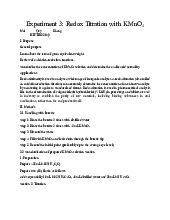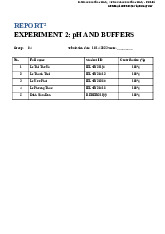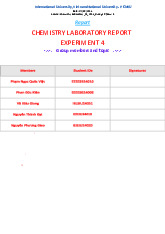


Preview text:
Lab Course Information - Chemistry for BME (BM098IU) Semester 2, 2023-2024
Instructor: Dr. Doan Ngoc Hoan 1. Course requirements
Students are expected to attend all lab sessions and arrive on time.
Absence is only allowed with prior approval. 2. Course outline
Lab 1. Introduction to analytical chemistry tools Lab 2. Acid – base titration
Lab 3. Potentiometric titration Lab 4. Separation methods Lab 5. Redox titration
Lab 6. UV-visible spectrophotometry Lab 7. Chromatography 3. Course evaluation
In-lab quizzes and pre-lab assignments (individual): 20% Lab reports (group): 50% Final exam: 30%
4. Lab report information
Lab report is due at the beginning of the next class (for example, Lab #2 report is
due at the beginning of Lab #3 class). 5. Lab safety
Safety precautions must always be taken during lab sessions. Failure to follow the safety
guidelines will result in your dismissal from the lab. A. Clothing
Wear proper clothing. Proper protective clothing must be worn by all persons in
the room at all times that anyone is working with, transporting glassware, or
conducting any experimental work. Exposed chemical to the skin is susceptible to
injury by splattering hot, caustic, or flammable materials. Students and instructors
must be protected from their necks down below their knees. This requirement
includes no shorts, no short skirts, no sleeveless garments, no bralettes, and no
bare midriffs. Long lab coats are required if shorts or short skirts are worn. Tight-
fitting clothing, long unrestrained hair, clothing containing excessive fringe, or
even overly loose-fitting clothing may be considered unsafe. Long hair must be
tied back, and no dangling jewelry.
Wear proper protective footwear. No sandals/flip-flops/crocs, no open-toed
shoes, and no foot covering with absorbent soles are allowed. Any foot protection
that exposes any part of one’s toes is unsuitable for wear in the laboratory.
Wear personal protective equipment. Very minor laboratory accidents, such as
the splattering of the solution, can cause permanent eye damage, skin burnt, or
acute burns of the respiratory system. Wearing personal protective equipment
(PPE), including gloves, goggles, and respirators, can protect laboratory workers,
and students, and prevent the majority of laboratory accidents. PPE is not required
in all cases. Course instructors and the teaching team will decide when wearing
PPE is essential for a particular laboratory section.
B. Handling chemicals, glassware and equipments
Only perform experiments under the supervision of an instructor or TAs.
Always handle chemicals with experiment gloves to prevent direct exposure of
chemicals onto skin, chemical contamination, or injuries due to glassware
breakage. Wear further insulated gloves when handling hot and cold glassware.
Beware of using any kind of acid, base and other concentrated reagents. Never
heat a liquid in a test tube that is pointed toward you or another student.
Never inhale gases or vapors unless directed to do so. If you must inhale the odor
of a gas or vapor, use your hand to waft a small sample toward your nose. Never
taste chemicals or perform pipetting by mouth, always use a mechanical suction
device such as graduated pipettes or micropipettes.
Never return residual chemicals to their original containers since used chemicals
might contaminate original chemical. Used chemicals or broken glassware should
be disposed appropriately according to the instruction of TAs. Report cuts, spills
and other problems to the TAs or lab managers.
Do not use or move any instruments in the lab unless directed to do so. Before
using read the equipment manual carefully. C. Behaviors
Performing unauthorized experiments is forbidden.
Never use an unknown or unmarked reagent. Do not drink, eat, smoke in the lab
area. Lab materials, chemicals and any equipment should never be taken from the laboratory.
All forms of pranks are never acceptable in the laboratory.
Prepare notebook and pen/pencils for experiment recording. Phones, laptop and
other electronic devices are not allowed unless directed to use.
Wash hands with soap after performing all experiments. Clean/ rinse work
surfaces and used equipment at the end of the experiment. D. Emergency procedures
If you experience a medical emergency, immediately inform the lab manager,
teaching assistant, and seek medical attention. Listed below are first aid guides for
situations that may occur in the lab.
Heat burns: Wash the wound with cold water and cover with a clean bandage.
Cold burns: Wash the wound with warm water and cover with a clean bandage.
Cut & scrape: Wash the wound under a flowing faucet until it stops bleeding.
Sterilize with ethanol 90 and cover o with bandage.
Bleeding: If bleeding does not stop, apply pressure with a clean bandage or cloth
over the wound until the bleeding stops. Further seek immediate medical help if bleeding remains.
Eye injuries: Remove contact lenses, flush out eyes with cold water for at least 15 minutes.
Poisoning: If the person is still conscious, ask them to sit still while waiting for
medical help to arrive. If poison was ingested, spit out if possible. If poison was
splashed on the skin or clothes, remove contaminated items, and wash the
contaminated area with water - be careful not to contaminate yourself.
Electric shock: Shut off electric power, remove the victim from electric power,
call the ambulance, perform CPR if no pulse and breathing is detected.




